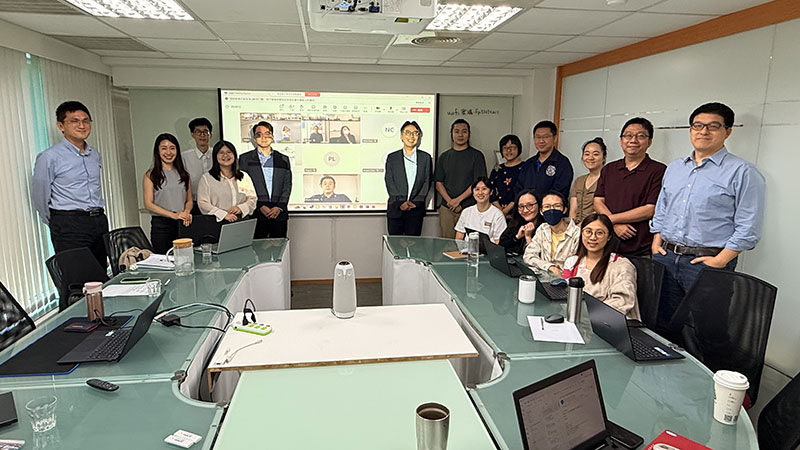Growth / Governance
Regulatory Compliance and Business Integrity
| Description of Importance | Impact Assessment | Value Chain Impact | Corresponding Section of Management Approach | ||
|---|---|---|---|---|---|
| Upstream | Midstream | Downstream | |||
| Business integrity is key to maintaining brand trust and long-term customer relationships. Violations or unethical behavior can damage corporate reputation, thereby affecting market position and revenue. | Regulatory compliance and ethical business practices are the foundation of sustainable business development. If a company fails to comply with relevant laws and regulations, it may face fines, lawsuits, or even business suspension. | ● | ● | ● | 2.4 Compliance with Laws and Regulations |
| Corresponding GRI Disclosure | GRI2-27 | Linked SDGs |

|
The vision of Formosa Pharmaceuticals is to become a leading biopharmaceutical company focused on ophthalmology, oncology, and anti-infective therapeutic areas, dedicated to the innovative development of pre-clinical and clinical-stage drug candidates. Business integrity is the cornerstone of the Company’s long-term and stable development. Failure to operate in compliance with laws and regulations may result in penalties from regulatory authorities, significantly damage the Company’s reputation, and undermine the confidence of shareholders and investors. Formosa Pharmaceuticals upholds the concept of integrity management and is committed to building a transparent and compliant corporate culture. The Company has established and implemented the “Code of Ethical Conduct”, “Ethical Corporate Management Best Practice Principles”, “Procedures for Ethical Management and Guidelines for Conduct”, and “Insider Trading Prevention Guidelines”. These internal policies cover the prohibition of unethical behavior, whistleblowing mechanisms, and penalties for violations, and are reviewed and updated regularly to continuously enhance corporate governance mechanisms, ensure that all business activities comply with relevant regulations, and effectively prevent any improper benefit-seeking behavior. Formosa Pharmaceuticals emphasizes the importance of integrity and transparency. Through the Board of Directors’ professional decision-making, in accordance with laws, the Articles of Incorporation, and resolutions of the Shareholders’ Meeting, the management team is guided to implement the Company’s integrity management policies. This ensures comprehensive internal and external governance, protects the rights and interests of the Company, shareholders, and employees, and lays the foundation for sustainable development.
Policy and Commitment
Formosa Pharmaceuticals has established the “Ethical Corporate Management Best Practice Principles” and “Code of Ethical Conduct” to regulate interactions between employees and healthcare professionals, implement the policy of ethical management, and actively prevent unethical behavior and any improper benefit-seeking activities.
- Policy: Adhering to the principles of integrity, transparency, and accountability, the Company formulates integrity-based policies approved by the Board of Directors and establishes robust corporate governance and risk control mechanisms to create a sustainable operating environment.
- Commitment: The Company and its affiliates and organizations shall explicitly state the policy of ethical management in internal regulations and external documents, and the Board of Directors and management shall actively implement the commitment to ethical management, ensuring execution in internal management and business activities.
Indicators and Targets
- Short-term: Enhance the depth of compliance training and reinforce a culture of integrity.
- Mid-term: Establish and publish disciplinary and grievance mechanisms for violations of ethical management regulations and promptly disclose on the Company’s internal website the violator’s title, name, date of violation, details of the violation, and handling status.
- Long-term: Strengthen the effectiveness of the whistleblowing mailbox.
Tracking and Management Mechanism
- The Company’s responsible unit shall periodically conduct internal awareness campaigns to communicate the importance of integrity to directors, employees, and appointees.
- The Company shall regularly organize training and education sessions for directors, supervisors, managerial officers, employees, appointees, and people with substantial control to ensure they fully understand the Company’s determination, policies, key preventive measures, and the consequences of unethical behavior.
- The Company shall integrate its ethical management policy with employee performance evaluation and human resource policies, establishing clear and effective reward and disciplinary mechanisms.
- The Company shall closely monitor developments in domestic and international ethical management regulations and encourage directors, supervisors, managerial officers, and employees to make suggestions for reviewing and improving the Company’s policies and measures, thereby enhancing the effectiveness of ethical management implementation.
Annual Actions and Results
- In 2024, Formosa Pharmaceuticals had no incidents of litigation or disputes related to pharmaceuticals, corruption, infringement of customer privacy, conflict of interest, or insider trading. Relevant policies and commitments were communicated through monthly management meetings, where related rights and obligations were reviewed to ensure proper implementation.
- The Company’s internal audit unit shall formulate relevant audit plans based on risk assessments of unethical conduct, including audit subjects, scope, items, and frequency, and conduct checks on compliance with preventive measures. Certified public accountants may be engaged to perform audits, and professionals may be consulted if necessary.
- Audit results shall be reported to senior management and the unit responsible for ethical management, and audit reports shall be prepared.
- To strengthen the management of ethical operations, the Company shall designate a dedicated unit responsible for the amendment, implementation, interpretation, consulting services, and registration/filing of reports under these Guidelines, as well as for supervising execution. The main responsibilities are as follows:
- Assist in integrating ethics and moral values into the Company’s business strategies and develop anti-fraud measures in compliance with relevant regulations.
- Periodically analyze and assess the risks of unethical behavior within the business scope, establish prevention programs accordingly, and set standard operating procedures and codes of conduct for relevant business operations.
- Plan internal organization, staffing, and responsibilities, and establish mechanisms for checks and balances for business activities with higher risk of unethical behavior.
- Promote and coordinate training and communication of the Company’s ethical management policies.
- Design and implement whistleblowing mechanisms and ensure their effectiveness.
- Assist the Board of Directors and management in auditing and evaluating the effectiveness of preventive measures for ethical management and periodically assess compliance with related business processes and prepare reports.
Intellectual Property Rights Management
| Description of Importance | Impact Assessment | Value Chain Impact | Corresponding Section of Management Approach | ||
|---|---|---|---|---|---|
| Upstream | Midstream | Downstream | |||
| In the biotechnology industry, the management of intellectual property rights is a material topic. Major technological breakthroughs often represent new business opportunities and collaboration potential. | Intellectual property rights management involves the protection of innovative products, technologies, or brands. If not properly managed, the company may face infringement or misappropriation of its innovations, resulting in reduced market competitiveness and economic loss. | ● | 2.7 Intellectual Property Rights Management | ||
| Corresponding GRI Disclosure | GRI 201-1 | Linked SDGs |

|
Policy or Commitment
- Policy: Clearly define intellectual property ownership by establishing clear internal agreements and contracts to clarify ownership of intellectual property among employees, partners, and external suppliers.
- Commitment: Clearly identify and register ownership of R&D achievements, innovative technologies, and other results, and ensure their protection.
Indicators and Targets
- Short-term: Establish a licensing mechanism related to intellectual property monetization.
- Mid-term: Formulate standard operating procedures (SOPs) for intellectual property rights management.
- Long-term: Include intellectual property rights management as a key performance indicator for the Company.
Tracking and Management Mechanism
The Company has established the “Trade Secret Management Regulations” and “Patent Application Management Regulations” as the main basis for management. The primary management methods include:
- Trade secret files must be managed by dedicated personnel, stored separately from non-trade secret files, and access to storage areas must be restricted.
- Trade secret files must be labeled “Confidential.”
- The responsible manager must record the filing, archiving, use, updating, and declassification of trade secret files.
Annual Actions and Results
The Company signs contracts with customers to license its patented technologies. Because licenses are distinct, license revenue is recognized either over the license term or at the point when control of the rights is transferred to the customer, depending on the nature of the license. At the time of signing, customers pay a non-refundable upfront payment, and milestone payments are made upon achieving defined milestones. When the Company performs activities that significantly affect the patented technology and directly affect the licensee, and such activities do not result in the transfer of goods or services to the customer, the license is considered to grant the right to access intellectual property. Related royalties are recognized as revenue on a straight-line basis over the license period. If the license does not meet the above conditions and is considered to grant the right to use intellectual property, revenue is recognized at the point in time when the license is transferred.








